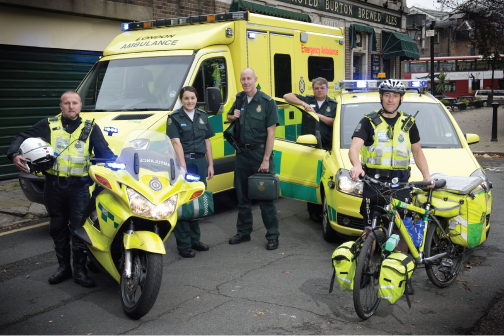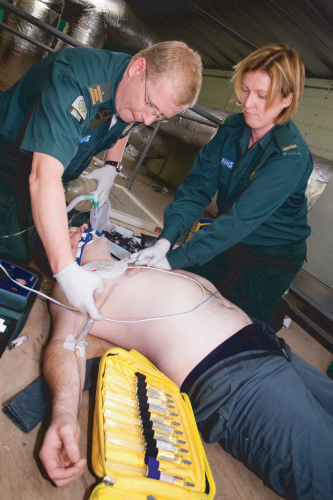Introduction
Out-of-hospital sudden death is a leading cause of death in the industrialised world. In Europe alone, 700,000 sudden cardiac arrests occur each year. There is marked variation in the incidence of and outcomes from out-of-hospital cardiac arrest between and within countries. This was highlighted in a recent systematic review that found 10-fold variation in incidence and outcomes for out-of-hospital cardiac arrest. In the UK, analysis of early data from the National Ambulance Quality Indicators shows variation in return of spontaneous circulation (ROSC) rates (13.3–26.7%) and survival to hospital discharge (2.2–12%). The sources of such variation may be related to the data (e.g. case and data definitions), patient (e.g. co-morbidities, age), environmental (e.g. location of arrest, whether it was witnessed, whether bystander CPR is commenced), EMS process variables (EMS response time, quality of CPR) and hospital variables (e.g. use of therapeutic hypothermia and percutaneous coronary intervention facilities). A systems approach covering the whole patient journey may help standardise and improve outcomes.
Emergency Medical System (EMS) response
The case for providing prompt and effective resuscitation at the scene of an emergency is overwhelming and a variety of emergency care roles exist in the pre-hospital arena. The majority of acutely unwell patients seeking help will most commonly receive a response in the form of a double manned ambulance staffed by paramedics and/or emergency medical technicians (EMTs). In many areas, single responders in a car, motorcycle or pushbike are used increasingly to undertake initial assessment and treatment. Many paramedics have developed their clinical practice into specialist and advanced roles in both primary and critical care. These roles include paramedic practitioner, emergency care practitioner, critical care paramedic and consultant paramedic, operating not only in ambulance services but also with out-of-hours GP providers, in minor injury units and walk-in centres. In order to practice, all paramedics must now register with the Health Professions Council (HPC) and their education is moving towards the higher education model.
EMS dispatch
Emergency calls are categorised depending on the condition of the patient. The highest priority, ‘category A’, is reserved for patients with an immediately life-threatening condition such as cardiac arrest, chest pain, severe difficulty in breathing, time-critical stroke or severe haemorrhage. It is standard practice for a rapid response unit (in the form of a car, motorbike or even pushbike) to be sent as an initial resource prior to the arrival of an ambulance to undertake initial assessment and treatment. Figure 11.1 illustrates typical frontline responses, one or more of which may be dispatched to a 999 call.
Other pre-hospital providers include air ambulance teams and BASICS doctors. The nature of calls that air ambulances are dispatched to depends considerably on the geographical area. For example, in London there is one air ambulance which attends major trauma. In more remote regions of the country, helicopters may be dispatched to ‘medically unwell’ patients, for instance those suffering a heart attack or stroke. BASICS doctors are specialists that have received specific training on how to work outside the hospital environment. They provide specialist support to augment the ambulance service response.
Initial assessment
On arrival at the scene, paramedics will perform an assessment of the patient to identify their immediate healthcare needs. This may involve making critical decisions regarding treatment and may include performing life-saving interventions before triaging the patient to an appropriate centre. The remit of the standard paramedic role may include managing any medical or trauma-related incident from abdominal pain to a multi-patient road traffic collision. Box 11.1 lists the conditions where paramedics can play a vital part.
- Cardiac/respiratory arrest
- Acute coronary syndromes (ACS)
- Stroke
- Asthma, chronic obstructive pulmonary disease
- Heart failure
- Obstetric emergencies
- Trauma
- Diabetic emergencies
- Airway obstruction
- Drug overdose
- Life threatening cardiac arrhythmias
- Anaphylaxis
Pre-hospital interventions
Paramedics are trained to perform advanced life support (ALS) and a range of life-saving interventions (see Box 11.2). Figure 11.2 depicts a paramedic crew performing ALS in the pre-hospital environment. Paramedics may deliver a wide range of drugs, the majority of which are set out in Box 11.3. Specialist paramedics may also prescribe and administer a range of drugs under ‘patient group directions’ which previously may only have been prescribed by a GP or in hospital.
Figure 11.2 The range of frontline responses, one or more of which may be dispatched to an emergency call.

Stay updated, free articles. Join our Telegram channel

Full access? Get Clinical Tree









